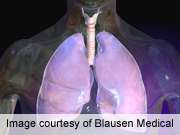(HealthDay)—There are no significant clinical differences between the use of a breath-actuated nebulizer (BAN) and a handheld nebulizer (HHN) for the treatment of wheezing or dyspnea among adults seen in the emergency department, according to a study published in the March issue of the Journal of Emergency Nursing.
Dominic Parone, B.S.N., R.N., from the Cooper University Hospital in Camden, N.J., and colleagues randomized 54 patients presenting to the emergency department with dyspnea and wheezing and an Emergency Severity Index of 3 or 4 to receive either BAN or HHN. One to three nebulizer treatments ([1] ipratropium bromide and albuterol sulfate; [2] ipratropium bromide and albuterol sulfate; [3] albuterol sulfate) were administered, consistent with guidelines.
The researchers observed no significant difference between HHN and BAN with respect to number of treatments, respiratory rate, peak flow measurements, and Modified Borg scores. In the BAN treatment group there was a difference of 7 points in pulse rate between the pre- and post-second treatment (51 patients; P = 0.01). Among BAN group participants who completed all three treatments (18 patients), total treatment time was on average of 10 minutes longer than those in the HHN group.
"The data [suggest] that the higher cost and the longer treatment time do not justify the use of the BAN in this setting," the authors write.
More information:
Abstract
Full Text (subscription or payment may be required)
Journal information: Journal of Emergency Nursing
Copyright © 2014 HealthDay. All rights reserved.






















